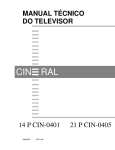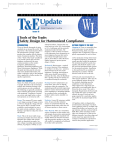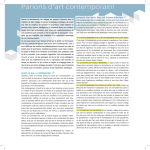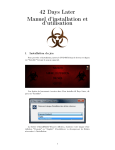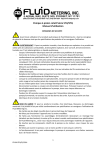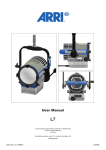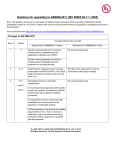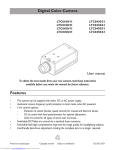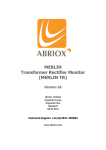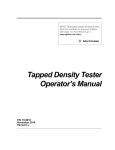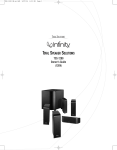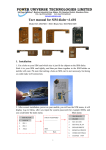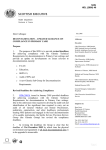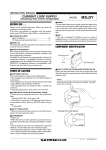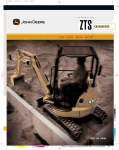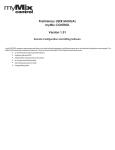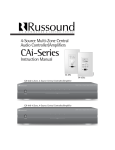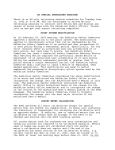Download Designing for Success - Washington Laboratories
Transcript
Designing for Success Product Safety Compliance Berri Remenick NARTE Certified Product Safety Engineer Product Safety Manager Washington Laboratories, Ltd. Laboratory Workshop June 18, 2004 Frederick, MD Washington Laboratories (301) 417-0220 web: www.wll.com 7560 Lindbergh Dr. Gaithersburg, MD 20879 Overview ¾ North American Requirements ¾ European Requirements ¾ Product Safety Hazards ¾ Product Safety Design Guidelines for 60950-1 and 61010-1 North American Safety Requirements • Product Liability • • Customer demands • • Threat of Product Liability Lawsuits Contractual Requirements Legal requirements • • • • • Occupational Safety and Health Agency (OSHA) (CFR 1910.399) for workplace safety National Electric Code: NEC requires listing of products connected to telephone lines Local Laws. Enforced by local authorities Canadian Provincial Laws Mexican Product Safety Requirements North American Safety Requirements Routes to Conformance • • • • USA - Underwriters Laboratories, Inc. (UL) - NRTL: Nationally Recognized Testing Laboratories accredited by OHSA (TUV, NTS, etc) Canada • CSA • c-UL • c-NRTL (cTUV) Mexico - NOM UL Standards (a short list) UL 60950-1*: Information Technology Equipment (formerly UL1950) UL 6500*: Audio-Video Products and Accessories (formerly UL1492 and UL1409) UL 60601-1: Medical Electrical Equipment (former UL 2601-1) UL 508: Industrial Control Equipment UL61010A-1: Lab equipment (formerly UL3101-1) * WLL is in the UL CAP Engineering Program for these standards European Safety Requirements ¾ ¾ ¾ ¾ ¾ ¾ New Approach Directives • Self-Certification • Technical Construction File Evidence of conformity to essential requirements • EMC and Safety Intended for Market Inspectors Documentation to support the use of the CE Marking is required. Manufacturer Affixes CE Mark Notified Body Required for some products European Safety Requirements Routes to Conformance ¾ Self declare by using CE Mark ¾ Use CE Mark with a competent body review ¾ Obtain TUV, VDE, or other European safety approval mark in addition to CE Mark • Member States • • • • • • • • Austria Luxembourg The Netherlands Portugal Spain Sweden United Kingdom Ireland Italy Belgium Denmark Finland France Germany Greece New members coming….. • • • • • • • Norway Iceland Lichenstein Czech Republic Cyprus Estonia Latvia Hungary Lithuania Malta Poland Slovakia Slovenia Low Voltage Directive ¾ ¾ ¾ ¾ ¾ Has been around since 1973 - recently amended (1993) to include the use of the CE Marking. For products intended for connection to Mains voltages between 50 and 1000V~. Generally for household products, office or laboratory equipment - NOT for machinery or medical products. For products where hazards are primarily electrical in nature. Documented internal QUALITY ASSURANCE required. Low Voltage Directive Common Standards ¾Information Technology Equipment EN60950 ¾Laboratory Equipment EN61010 ¾Audio Video Equipment EN60065 ¾Household Appliances EN60335 Other Common Directives ¾ ¾ ¾ ¾ RTTE Directive: For products connecting to the telephone network or containing radio transmitters. Requirements for the Low Voltage Directive apply without minimum voltage limitations. General Product Safety Directive: “Catch all” directive stating that all products must be safe. Machinery Directive: For devices with hazards primarily mechanical in nature. Medical Devices Directive: For Medical Devices. NEW APPROACH DIRECTIVES • • • • • • • • • • • • • • • • • • • • • - Low Voltage (73/23/EEC) Amended by 93/68/EEC -Simple Pressure Vessels (87/404/EEC) Amended by 90/488/EEC -Toy Safety (88/378/EEC) Amended by 93/68/EEC -Construction Products (89/106/EEC) Amended by 93/68/EEC -EMC (89/336/EEC) Amended by 93/68/EEC -Machinery (98/37/EEC) -Personal Protective Equipment (89/686/EEC) -Non-Automatic Weighing Instruments (90/384/EEC) Amended by 93/68/EEC -Appliances burning gaseous fuels (90/396/EEC) Amended by 93/68/EEC -Radio Equip & Telecom Terminal Equipment (91/263/EEC) -Hot Water Boilers (92/42/EEC) Amended by 93/68/EEC -Medical Devices (93/42/EEC) -Recreational Craft (94/25/EEC) -Active-implantable medical devices (90/385/EEC) Amended by 93/42/EEC -Explosives for civil uses (93/15/EEC) -Equipment explosive Atmospheres – ATEX (94/9/EC) -Packaging and Packaging Waste (94/62/EEC) -Lifts (95/16/EC) -Pressure Equipment (97/23/EC) -In-vitro diagnostic medical devices (98/79/EC) -Cableway installations designed to carry persons (2000/9/EC) Other Directives based on New Approach • • • • • • • -Interoperability of trans-European high speed rail system (96/48/EC) -Energy Efficiency requirements (96/57/EC) -Marine Equipment (96/98/EC) Amended by 98/85/EC -Interoperability of trans-European conventional rail system (2001/16/EC) -Transportable pressure equipment (1999/36/EC) -Noise emission in the environment by equipment for use outdoors(2000/14/EC) -Energy efficiency requirements for ballasts for fluorescent lighting (2000/55/EC) What is a TF ? ¾ A Technical File (TF) brings together all required elements to show compliance with applied standards and incorporates the items outlined in the directive. ¾ The TF is a neat, organized, professionally prepared report which will be accepted by any authority in Europe ¾ The TF should make the product as understandable as possible to a third-party not familiar with the product The TF includes… • A Test Report • A clause-by-clause description of how the product complies with the requirements • Or why a particular requirement does not apply. The TF includes… • A Critical Component List (CCL) • CCL identifies all components related to product safety • Lists the manufacturer, part number, approvals, and ratings • Must be a link to agency certificates(TUV,VDE, UL), manufacturer’s declarations of conformity, or test data to back up the claims of compliance. • NOTE: There MUST be a Specifications and Certification/Declaration or Test Data for every component in the CCL. The TF includes… • Drawings, schematics, and parts list • All items relevant to Product Safety should be available • Must be clear and legible and correspond with the sample identification • Block Diagram is very useful to quickly illustrate a product’s electrical interconnections. The TF includes… • Specifications • Provide design and performance criteriamay not indicate the safety related limits or ratings • Should be available for every component listed in the CCL • Used to verify proper application of the relevant parts only when the information does not appear on an official document (agency certificate, mDOC). Spec Sheet Example The TF includes… • Declarations and Certifications • Are required for verifying compliance of components used in the systems • mDOCs should be properly formatted and contain the correct part number (traceable back to the specification and CCL listing) • Certifications should have the correct part number (traceable back to the specification and CCL listing) and the standards applied Certificate Example The TF also includes… ¾ Installation/User/Service Instructions ¾ Photographs ¾ Copy of the Declaration of Conformity Declaration of Conformity Application of Council Directive (s): 89/336/EEC, 72/23/EEC Standard(s) to which Conformity is Declared: EN55022, EN60950 Manufacture’s Name: Manufacture’s Address: COMPANY NAME ADDRESS Importer’s Name: Importer’s Address: (EU Representative’s Name) (EU Representative’s Address) Type of Equipment: EQUIPMENT DESCRIPTION Model Number: MODEL NUMBER Year of Manufacturer: (Year of Manufacture) I, the undersigned, hereby declare that the equipment specified above conforms to the above Directive(s) and Standard(s). __________________________ (Full Name, Title) __________________________ (Signature) _ _________________________ (Date) Anatomy of a Technical File Cover Page OPTIONAL Schematics EMC EMC Report Report Safety Safety Report Report Test Equip. List Parts List Photos Photos Ratings Label User’s User’s Manual Manual Theory Of Operat’n Specs Specs Certs Certs Test Plan EMC Design Quality System Risk Assess. Product Safety Hazards addressed in 60950-1 and 61010-1 ¾ Electric Shock ¾ Energy ¾ Fire ¾ Mechanical ¾ Radiation ¾ Thermal Electric Shock Hazards: ¾ ¾ ¾ High voltage at low frequency can travel through the heart and cause ventricular fibrillation. Higher frequencies can cause burns. Voltages above 30Vrms or 60Vdc considered hazardous. Energy Hazards: ¾ ¾ High current at low voltage can cause insulation or other parts to ignite and start a fire. Excessive current can cause metal parts to fragment, creating a physical hazard from shrapnel. Fire Hazards: ¾ Excessive temperatures can ignite materials inside the equipment or in close proximity to external surfaces. ¾ Beside the danger of the fire itself, the release of toxic gases is a concern. Mechanical Hazards: ¾ Moving parts. ¾ Expelled parts. ¾ Motor overspeed. ¾ Locked rotors or motor shafts. ¾ Sharp edges. Radiation Hazards: ¾ Ultraviolet. ¾ Laser. ¾ Sonic (audible noise) ¾ Ionizing. ¾ Damage to the components in the equipment must be considered in addition to hazards to the operator or service personnel. Thermal Hazards: ¾ Excessive external temperatures may cause burns. ¾ High temperatures may start a fire or degrade insulation. Product Product Safety Safety Design Design Guidelines Guidelines for for 60950-1 60950-1 and and 61010-1 61010-1 ¾ ¾ ¾ ¾ ¾ ¾ ¾ Design and Construction Requirements Labeling and Markings Instructions Manuals Language Wiring and Connection to the supply Resistance to Fire and control of spread of fire Connection to Telecommunications Network Design Design Requirements Requirements Protection against electric shock and energy hazards: • The OPERATOR can not touch bare or inadequately insulated parts at hazardous voltage or energy levels. • Hazardous Voltage Level is typically >30Vrms, 42.4Vpeak, or 60VDC. Hazardous energy is typically >240VA or 8A Protection may provided via insulation, guarding or interlocking. What is Insulation? • Physical barrier between two parts (tape, plastic shield, wire insulation, enclosure, etc) • Separation between two parts (creepage or clearance distance) Insulation Types • Functional / Operational Insulation (DC input to ground) • Basic Insulation (Primary to Ground, TNV to Ground, TNV to SELV) • Reinforced Insulation (Primary to Secondary) Reinforced Insulation Example Spacings ¾ Determine insulation required for your circuit. ¾ Determine maximum working voltage for your circuit. ¾ Go to tables in standard and determine required creepage and clearance distances. ¾ Maintain these distances in your design. Creepage / Clearance Creepage ¾ Creepage = distance between two points along the surface ¾ Creepage is measured on 1:1 artwork or on a blank board ¾ Locations of circuits determined by reviewing schematics Clearance ¾ Clearance = distance between two points through the air ¾ Clearance sample is measured on a populated Abnormal Abnormal Operation Operation “None of the following conditions shall create a hazard within the meaning of the Standard:” ¾ ¾ ¾ ¾ ¾ ¾ Fan Fail Transformer Overload Component Short- and Open-circuits Failure of unapproved Thermal Limiting device. Locked Rotor. and others, depending upon equipment. Labeling Labeling and and Marking Marking ¾ ¾ ¾ ¾ ¾ ¾ Rated voltage, current or power, frequency Manufacturer’s name or registered trademark. Model or type number. Fuse replacement info (if applicable). IEC symbols wherever possible. Warnings and Cautions appropriate for the particular equipment. User User Instructions Instructions ¾ ¾ ¾ ¾ ¾ ¾ Installation Instructions - information regarding mounting, connection to the supply, ventilation, input ratings, etc. All information regarding use, cleaning, maintenance (if necessary). All safety warnings and cautions. Restricted Access Location statement if applicable. Rack Mount instructions. Instructions for Racks. Language Language ¾ ‘Safety-related’ information to be in appropriate language. ¾ Service Instructions may be in English. ¾ Many times, the entire User Manual must be translated (for specific market areas, dependent on intended end-user, etc). Wiring and connection to the supply – Protective Earth ¾ ¾ ¾ ¾ ¾ ¾ PE conductor must be green/yellow or bare insulation conductor PE connections must be double secured so that both the wire and insulation are crimped IEC PE symbol shall be marked adjacent to PE stud PE conductor shall connect to chassis directly from input (inlet, terminal block, etc). PE conductor must be secured with washer and locknut. Additional PE conductors can be secured to PE stud with a second washer and locknut. PE Stud Example EMI FILTER CHASSIS CONNECTION MECHANICALLY SECURED GROUND: GREEN/YELLOW WIRE SAME GAUGE AS OR BIGGER THAN SUPPLY TO OTHER GROUNDS Wiring and connection to the supply – Primary Wiring ¾ • • • ¾ All AC wires shall be double secured. Double securement can be met by: Double crimp connector or Single crimp connector and cable tie or Single crimp connector and shrink sleeving. AC wiring shall be rated for the maximum working voltage and current. ¾ AC wiring shall be isolated from low voltage wiring or low voltage parts, this can be accomplished by: • Shrink sleeving the AC conductors or • By routing the AC conductors away from low voltage wires • and securing with cable ties or • By using UL1015 Reinforced Insulation wire. Resistance to fire and control of fire spreading Flammability of enclosure, internal, and external parts • Flammability ratings • • • • • • • • 5VA 5VB V0 V1 V2 HB40 HB75 Resistance to fire and control of spread of fire 60950-1 • Fire enclosure openings shall be: • • • • • • Top and side openings shall be: less than 5mm in any dimension or less than 1mm in width regardless of length or meet the 5° projection rule. There shall be no bottom openings (some exceptions allowed but difficult to meet) Methods for Meeting Fire Requirements in 61010-1 • Requirement: There shall be no spread of fire outside the equipment in Normal or Single Fault Conditions. • Methods of Compliance: A: Testing in single fault conditions B: Reducing sources of ignition within the equipment C: Containing fire within the equipment should it occur • • • Electrical Enclosure • 60950-1 • Even if fire enclosure is not required an electrical enclosure is required for hazardous parts. • Electrical enclosure openings shall: - be less than 5mm in any dimension or - be less than 1mm in width regardless of length or - meet the 5° projection rule or - not allow access to hazardous parts via the test finger or test pin. • • • • • • Electrical Enclosure • 61010-1 • Not allow access to hazardous parts via the test finger or test pin. • Test pin 4mm diameter and 100mm long shall not contact hazardous parts when suspended vertically. Connection to Telecommunications Networks (60950-1) ¾ ¾ ¾ TNV-1: Within SELV limits, but subject to overvoltages (goes outside the building). T1, T3, DS1, DS3, etc. TNV-2: Exceeds SELV voltages, but not subject to overvoltages (does not leave the building). Unit which generates a ringing signal to connect to a local phone. TNV-3: Exceeds SELV limits and is subject to overvoltages (goes outside the building). Port that connects to the PSTN. Overvoltage Tests – see flowchart in UL60950-1 ¾ ¾ ¾ ¾ ¾ ¾ ¾ 600V 40A 1.5s - Not required if 26AWG cord is specified 600V 7A - 5s 600V 2.2A - 30 minutes 600V 135% fuse rating - 30 minutes (if fuse blows during 2.2A test, the fuse is bypassed and repeated at this level) __V at 2.2A or 135% fuse rating - 30 minutes (if MOV rated to conduct at >285V, test is repeated at voltage just below conduction voltage) All overvoltage tests are conducted in Metallic (tip to ring) and Longitudinal (Tip and Ring to ground) modes. If unit does not have a ground connection, then only metallic mode is performed. All overvoltage tests are conducted in both On-hook and Offhook modes (therefore unit must be able to stay off-hook for 30 minutes) Overvoltage Test Example Overvoltage Test Example Common Non-compliances Discovered During Safety Evaluations ¾ ¾ ¾ ¾ Not using European approved components (requires additional testing) CE marked components meet EMC requirements only, not safety (requires additional testing). Inadequate Labeling (Warning labels don’t use IEC symbols, no voltage ratings, no Protective Earth labels, etc.) Overcurrent protection not provided (Fuses, circuit breakers, etc.) Common Non-Compliances Continued ¾ ¾ ¾ ¾ Improper Primary Wire Connection Methods Improper Protective Earth Connection Methods Not providing adequate documentation (schematics, wiring diagrams, manuals, parts lists, etc.) Not considering Creepage / Clearance requirements (Requires re-designing circuit boards) Washington Washington Laboratories, Laboratories, Ltd. Ltd. ¾ ¾ ¾ ¾ ¾ ¾ Help you select the proper Directives and Standards to apply to your product. Evaluate your product to the appropriate Safety Standard and offer solutions for noncompliances. Provide product design assistance. Assist in obtaining UL or NRTL, c-UL or cNRTL, GS Mark, and other approvals. WLL is approved under the UL CAP Program for UL60950 and UL6500. WLL is a Partner Test Lab for TUV Rheinland of North America for 60950, 61010, and 60065 Washington Laboratories, Ltd. • Give us a call or send us info about your product we’re here to help! • Berri Remenick Product Safety Manager Phone: 301-473-1255 Fax: 301-473-1257 E-mail: [email protected] • • • •































































